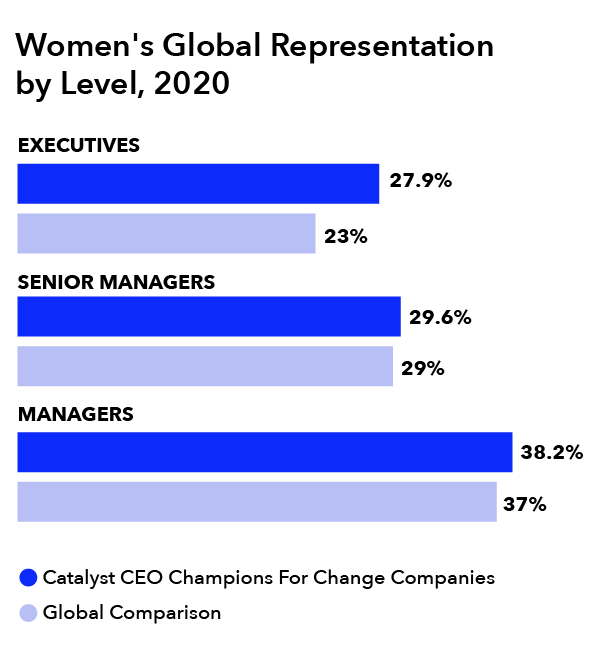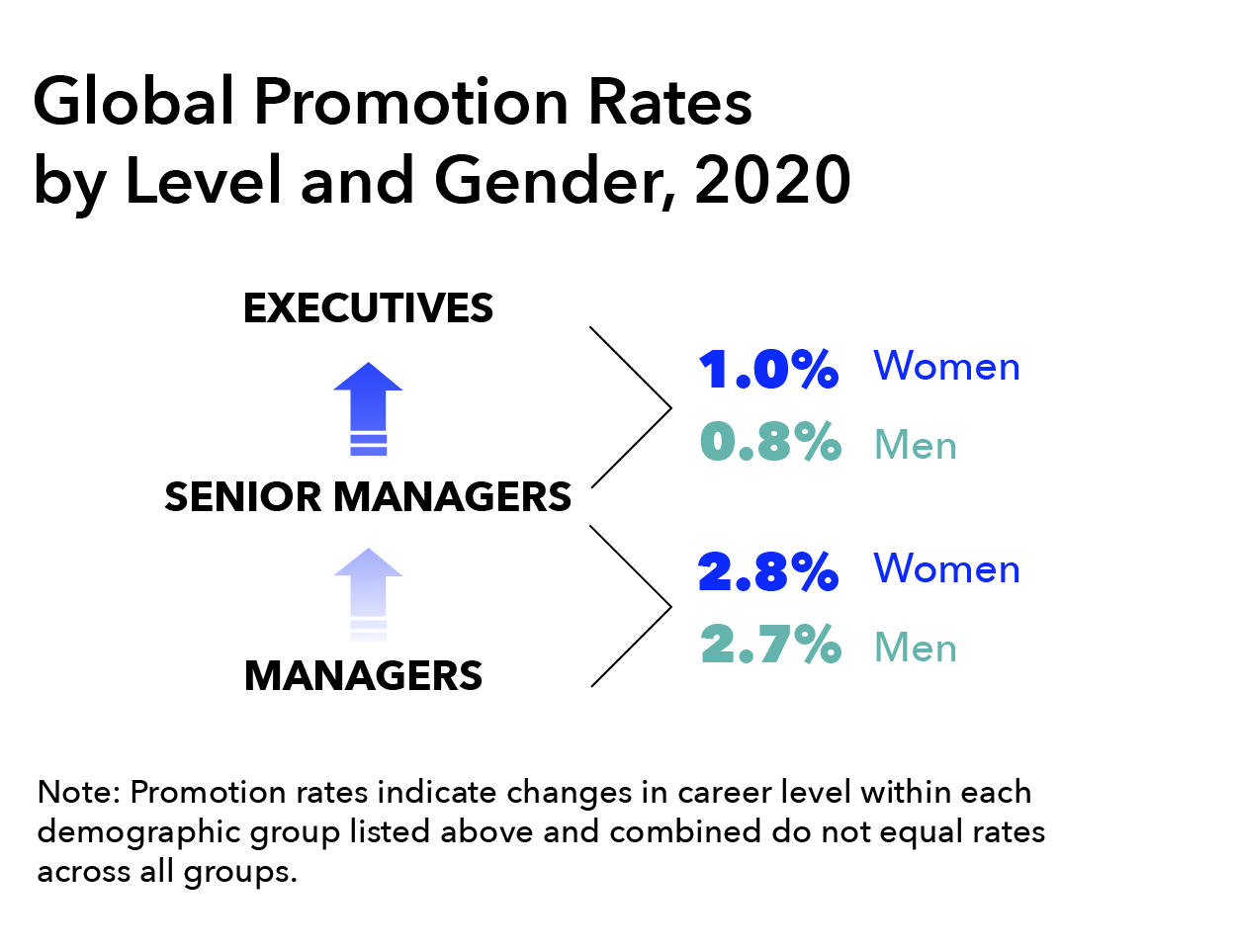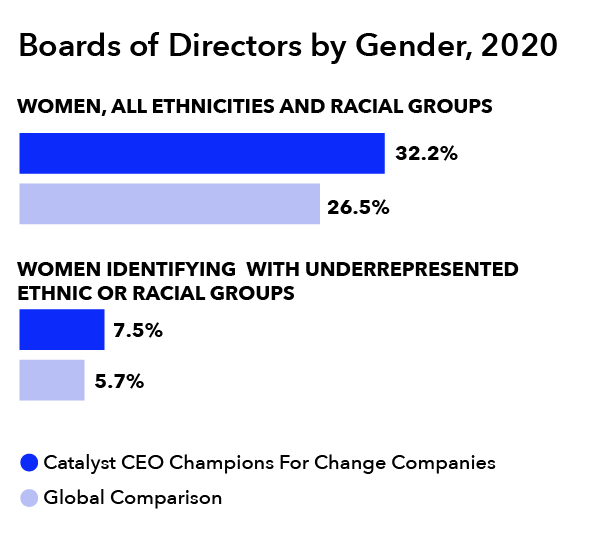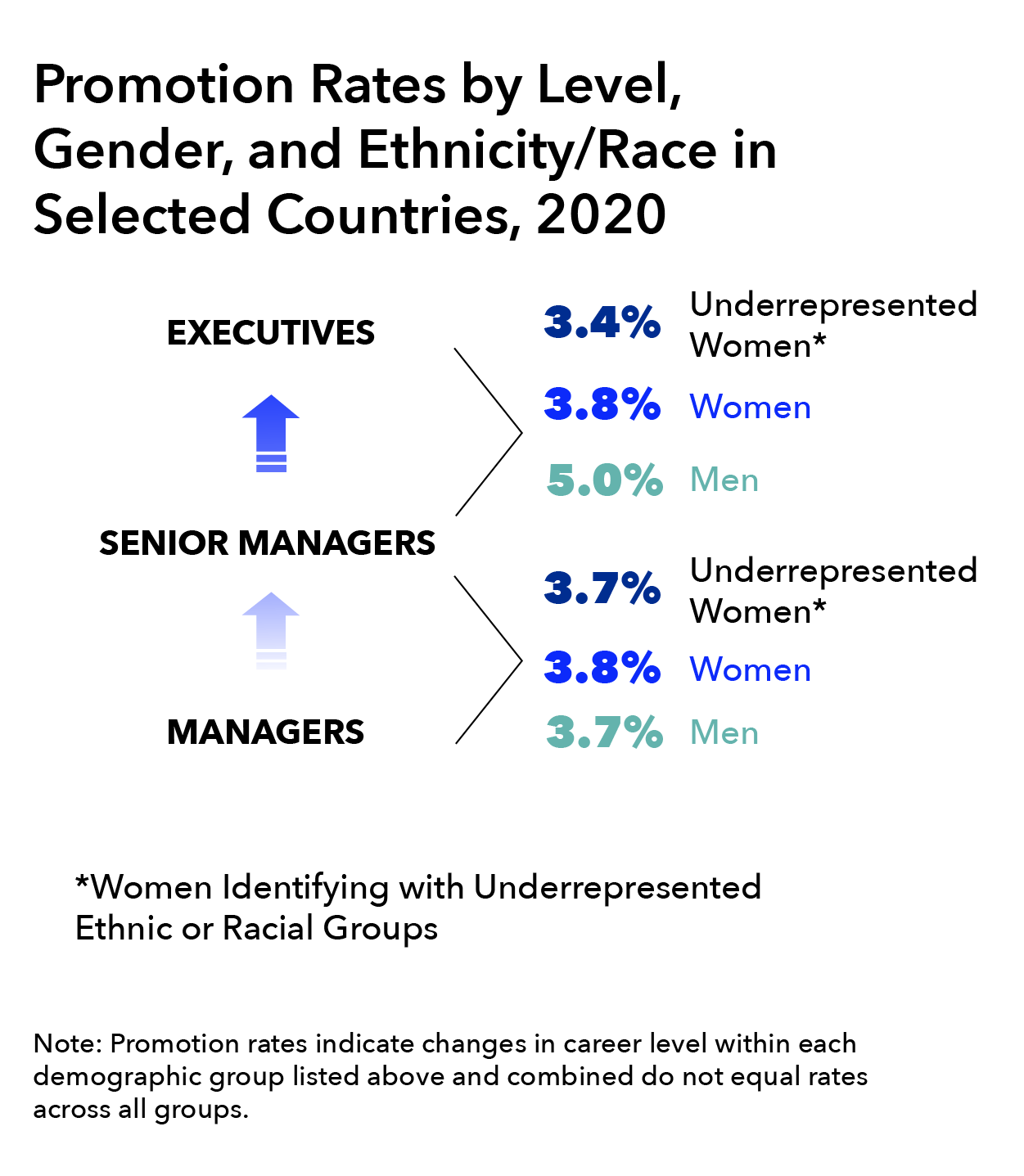Prioritizing Equity at a Pivotal Moment
The Catalyst CEO Champions For Change
The Covid-19 pandemic has had a devastating impact on women both professionally and personally. In the workforce, women lost more jobs than men.1 At home, where women were already doing the bulk of unpaid care work,2 they picked up online schooling for children, caring for aging parents, and other pandemic-related activities at a higher rate than men.3
These disadvantages are extending into the economic recovery, too. As the world begins to resume operations, women’s employment is lagging men’s.4 Globally, men’s employment has returned to pre-pandemic levels; however, by the end of 2021, it’s projected that the number of women in the workforce will still be 13 million jobs short of pre-pandemic levels.5
With the unique challenges women face, it will take focused and thoughtful effort to reimagine the workplace and return to pre-pandemic employment levels. A combination of inclusive solutions like hybrid work models and flexible work arrangements with robust talent management practices will be necessary to ensure women can effectively return and advance in the workplace. Without this, there is a very real possibility that the pandemic could wipe out decades of modest progress.
I’m grateful for the opportunity to partner with the Catalyst CEO Champions For Change who consistently demonstrate and tout the value of diversity, equity, and inclusion initiatives. Their willingness to champion hybrid work models—which are critical in enabling women to fully participate in the workforce—and find other creative solutions to attract, retain, and advance women is inspiring. It’s exactly this kind of leadership that we need to ensure we don’t let the pandemic erase decades of progress.
– Lorraine Hariton, President & CEO of Catalyst
“As we adjust to the new normal, it’s imperative that we don’t leave women behind in the rebuilding of our global workforce.”
Leading the Way: The Catalyst CEO Champions For Change
The Catalyst CEO Champions For Change were not immune to the effects of Covid-19. These 70+ CEOs were called on to lead a collective 11 million employees6 through one of the most tumultuous times in recent history. In this environment, it would have been easy to let diversity, equity, and inclusion (DEI) initiatives fall to the wayside as their organizations grappled with other issues. But times of crisis call for creativity and innovation. And, as our CEO Champions know, companies with diverse workforces and inclusive business cultures are more likely to report increased innovation, more effective team problem-solving, and higher productivity, among other benefits.7
Instead of de-prioritizing DEI, the Champion companies remained committed to their pledge of advancing women, particularly women of color, into leadership roles.
Champion Companies Continue to Outperform Their Peers
This year, we are thrilled to report that even in light of the Covid-19 pandemic, the Champion companies continue to lead by example in making their workplaces work for women. They had more women at every career level, as a group, compared to their global peers8—in manager, senior manager and executive roles. The difference is most pronounced in the executive ranks: women represent 27.9% of executives among Champion companies compared to 23% among their global peers.9
For the first time, a subset of Champion companies provided metrics on promotions in an effort to determine if the advancement of women was comparable to men.10 We are proud to report that these companies did in fact promote women at nearly equal rates as men in 2020, an especially challenging year. In fact, when looking at promotion rates between levels, our Champion companies promoted women at slightly higher proportions than men into senior leadership positions. This is particularly notable given the talent management obstacles that many companies faced in 2020 and the fact that women are still vastly underrepresented in leadership roles in general.11


Women’s representation at the board level is even more impressive; nearly one-third of board directors at our Champion companies are women—compared to only 26.5 percent for Fortune 500 companies.12
The Catalyst CEO Champions For Change have embraced diversity across not only gender, but also ethnicity and race. Champion companies have more women from underrepresented ethnic or racial groups in their board rooms versus their Fortune 500 peers,13 demonstrating quite visibly their commitment to equity for everyone.

Spotlight Story: Zoetis
Champion Companies Are Creating a Strong Pipeline of Women of Color
As the board data show, Champion companies are succeeding at diversifying across ethnicity and race at the top of their organizations. We wanted to know if that was a bellwether for lower-level positions and collected additional data on ethnicity and race across six countries—Australia, Brazil, Canada, South Africa, the United Kingdom and the United States.14
We found that similar to last year,15 the Champion companies have demonstrated their commitment to women from underrepresented ethnic or racial groups at all levels, with the strongest representation at the manager level. Additionally, promotion rates in 2020 were nearly equal for this group from manager to senior manager compared to women and men of all ethnicities and races. More work needs to be done to see higher numbers of women of color—and women in general—progress to the executive ranks, but the Champion companies are building an excellent foundation for diverse teams throughout their organizations.


Spotlight Story: Flex
Pause. Reflect. Act.
While the pandemic created unprecedented challenges across all aspects of society, it’s also been a time of incredible innovation. Corporations, schools, places of worship, grocery stores, and restaurants pivoted overnight and developed solutions for operating in a contactless, virtual world. People rose to the challenge.
To position themselves for success, organizations will need to continue creating innovative solutions: something that diverse teams do better than anyone.16 Now is exactly the right time to prioritize DEI initiatives.
Pinpoint your organization’s greatest areas of opportunity to advance women, particularly women identifying with underrepresented ethnic or racial groups.
- Leverage your internal workforce data with Catalyst’s Vital Signs toolkit. Disaggregate your data by gender, ethnicity, race, and other intersecting identities by level to diagnose talent gaps. Design policies and practices to build a more inclusive pipeline to senior leadership.
- Evaluate and monitor how your teams and employees are experiencing inclusion through the Catalyst Inclusion Accelerator.
Create customized, actionable solutions.
- Design inclusive, flexible work options and hybrid work models that work for your company.
- Develop fair and transparent talent management systems and procedures, including objective advancement criteria, specific and constructive feedback, and equitable allocation of “hot jobs.”
- Enhance your sponsorship programs. Sponsorship is an important career accelerator for women, particularly those from underrepresented ethnic or racial groups. Leaders who start early building a sponsorship mindset can make a significant impact on building an inclusive pipeline for their organization.
Track and measure progress against goals.
Catalyst has long promoted that “you can’t fix what you don’t measure.” Establish metrics to hold your organization accountable and track progress.
- Commit to DEI measurement and transparency by joining the group of organizations that are implementing the Gender and Diversity KPI Alliance’s three performance indicators.
- Better understand the state of diversity in your workforce by rolling out inclusive self-identification initiatives.
- Establish DEI targets and mechanisms for holding senior leaders accountable for progress.
Spotlight Story: Raytheon
A Historic Moment
We are at an inflection point in the history of the women’s movement. We can either let the ravages of the pandemic take away decades of progress, or we can address the disadvantages women endured because of Covid-19 by developing robust initiatives focusing on their re-entry, recruitment, advancement, and retention. Which side of history do you want to be on?
Methodology
These findings are based on responses to a survey distributed to all Catalyst CEO Champions For Change companies that were eligible to submit. Seventy-two companies responded to the survey and self-reported employee demographic data for their fiscal years in 2019 and 2020. The survey findings are reported in aggregate to protect the anonymity of the respondents and the confidentiality of their data.
Survey participants were asked to provide the following data:
- The number of employees globally by job level and gender. This number includes representation at the beginning and end of the fiscal year and employees who received promotions during the fiscal year.
- The number of employees globally by job level, gender, and ethnic or racial identity. This includes representation at the beginning and end of the fiscal year and employees who received promotions during the fiscal year. Participants had the option to self-select and provide data for up to six countries (Australia, Brazil, Canada, South Africa, United Kingdom, and United States) for this section.
- The number of members among the board of directors, by gender identity and ethnic or racial identity.
To provide consistent measurements of ethnic or racial identity across countries, participants were asked to provide data on employees identifying with the majority group and those identifying with ethnically or racially underrepresented groups, tailored to the unique cultures and demographics of each self-selected country. Majority groups are defined as groups of people that “possess a disproportionate share of societal resources, privileges, and power.”17 Employees who identified with more than one ethnicity or race (i.e., multiracial or multiethnic) were included among the counts for underrepresented ethnic or racial groups, even if one of the groups with which they identified was the majority group.
This survey included three options for gender: women, men, and nonbinary employees. All three categories are included in the totals for the calculations listed below. Due to a small sample size, findings for the representation and promotion rates of nonbinary employees are not featured in this report.
Calculations are based on the following:
- Women’s global representation in leadership. The number of Catalyst CEO Champions For Change positions at a given level (executive, senior manager, manager) held by women globally, divided by the total number of Catalyst CEO Champions For Change positions at that same level globally.
- Global promotions for women and men. The number of promotions earned by women and men at Catalyst CEO Champions For Change companies out of one career level and into the next level (manager to senior manager levels and senior manager to executive levels) during the fiscal year divided by the total number of positions held by women and men, respectively, at Catalyst CEO Champions For Change companies at the initial level (manager or senior manager) at the beginning of the fiscal year.
- The representation of women identifying with underrepresented ethnic or racial groups in leadership. The number of Catalyst CEO Champions For Change positions at a given level (executive, senior manager, manager) held by women identifying with underrepresented ethnic or racial groups, divided by the total number of Catalyst CEO Champions For Change positions at that same level. These figures represent an aggregate of the six countries selected for this survey (Australia, Brazil, Canada, South Africa, United Kingdom, and United States), with the majority of responses coming from the United States.
- Promotions for women, men, and women identifying with underrepresented ethnic or racial groups. The number of promotions earned by women (all ethnic or racial groups), men (all ethnic or racial groups), and women identifying with underrepresented ethnic or racial groups at Catalyst CEO Champions For Change companies out of one career level and into the next level (manager to senior manager levels and senior manager to executive levels) during the fiscal year divided by the total number of positions held by women (all ethnic or racial groups), men (all ethnic or racial groups), and women identifying with underrepresented ethnic or racial groups, respectively, at Catalyst CEO Champions For Change companies at the initial level (manager or senior manager) at the beginning of the fiscal year. These figures represent an aggregate of the six countries selected for this survey (Australia, Brazil, Canada, South Africa, United Kingdom, and United States), with the majority of responses coming from the United States.
- Women’s representation among boards of directors.
- Women: The number of Catalyst CEO Champions For Change board of directors positions held by women, divided by the total number of all Catalyst CEO Champions For Change board of directors positions.
- Women identifying with underrepresented ethnic or racial groups: The number of Catalyst CEO Champions For Change board of directors positions held by women identifying with underrepresented racial or ethnic groups, divided by the total number of all Catalyst CEO Champions For Change board of directors positions.
Executives are “individuals who plan, direct, and formulate policies, set strategy, and provide the overall direction of the enterprise/organization. Residing in the highest levels of the organization, these executives plan, direct, or coordinate activities with the support of subordinate executives and staff managers. Likely to include those individuals within two reporting levels of the CEO, whose responsibilities [involve] frequent interaction with the CEO. In smaller organizations, this may include the CEO and his/her direct reports only.”18 For the purposes of this survey, this category includes executive committees and office/department heads in law firms, as well as executive leadership in professional services firms.
Senior managers include “employees who determine policy and direction of the organization or a functional area and direct its activities, usually through other managers. They control the selection of senior employees and the allocation of resources.”19 For the purposes of this survey, this category includes management committees in law firms and partners in professional services firms.
Managers include “employees who coordinate and organize the activities of a discrete unit or service within the organization, usually reporting to a senior manager. They establish operational and administrative procedures, formulate policy relevant to their areas, and organize, lead, and direct others to achieve their goals. Likely includes first- to mid-level managers.”20 For the purposes of this survey, this category includes partners in law firms and senior managers in professional services firms.
Boards of directors members include all board directors in corporations and professional services firms, as well as executive committee members in law firms for the purposes of this survey. Survey participants were asked to report data for all boards of directors members, which may span multiple countries/markets.
The survey findings for the global workforce representation were compared against the representation of all women among executives, senior managers, and managers across the 1,157 participating organizations in Mercer’s ILM Map database.21
The survey findings for boards of directors were compared against the representation of women, and specifically women of color, among boards of directors in the Fortune 500.22 These findings were not compared to the S&P 500 due to lack of reliable data on women of color.
This year’s Catalyst CEO Champions For Change findings are not comparable to Catalyst CEO Champions For Change findings from previous years.23 The total number of companies participating in the survey has increased year by year since the start of the initiative in 2017. The 2019 survey examined increases in women’s representation across leadership roles over a five-year period, drawing from the 2019 pool of surveyed companies. Additionally, the 2021, 2020, 2019, and 2018 surveys measured the representation of women across the leadership pipeline in the global workforce, while the 2017 survey examined women across the leadership pipeline in the US workforce only. All five surveys measured the representation of women of color in the United States; however, findings are not comparable across years because the definitions of job categories for this group changed in 2020 and the number of companies participating in the survey increased each year. The 2021 survey is the first Catalyst CEO Champions For Change survey to measure promotions in addition to representation.
View the Appendix for additional findings.
Acknowledgments
We thank our Advancing Women donors for their generous support.
Altria Group, Inc.
BMO Financial Group
Deloitte
Guardian Life Insurance Company of America
KKR
Raytheon Technologies
Carnival Corporation
Edward Jones
Linda L. Addison
Mary B. Cranston
Shellye Archambeau
How to cite: Prioritizing equity at a pivotal moment: The Catalyst CEO Champions For Change. (2021). Catalyst.
Endnotes
- Policy brief: Building forward fairer: Women’s rights to work and at work at the core of the Covid-19 recovery. (2021). International Labour Organization.
- The detrimental impact of Covid-19 on gender and racial equality. Quick Take. (2020). Catalyst; Charmes, J. (2019, December 19). The unpaid care work and the labour market. An analysis of time use data based on the latest world compilation of time-use surveys. International Labour Organization.
- Gender equality and the socio-economic impact of the Covid-19 pandemic. (2021). European Institute for Gender Equality; De Paz Nieves, C., Gaddis, I., & Muller, M. (2021). Gender and Covid-19: What we have learnt, one year later. The World Bank.
- Policy brief: Building forward fairer: Women’s rights to work and at work at the core of the Covid-19 recovery. (2021). International Labour Organization.
- Policy brief: Building forward fairer: Women’s rights to work and at work at the core of the Covid-19 recovery. (2021). International Labour Organization.
- Catalyst analysis of Catalyst CEO Champions For Change companies.
- Why diversity and inclusion matter. Quick Take. (2020). Catalyst; Lorenzo, R., Voigt, N., Schetelig, K., Zawadzki, A., Welpe, I. M., & Brosi, P. (2017). The mix that matters: Innovation through diversity. The Boston Consulting Group; Travis, D. J., Shaffer, E., & Thorpe-Moscon, J. (2019). Getting real about inclusive leadership: Why change starts with you. Catalyst; Women in business and management: The business case for change. 2019. International Labour Organization.
- Career-level definitions are based upon Mercer’s When Women Thrive research. Let’s get real about equality: When women thrive 2020 global report. (2020). Mercer.
- Career-level definitions are based upon Mercer’s When Women Thrive research. Let’s get real about equality: When women thrive 2020 global report. (2020). Mercer.
- This survey included three options for gender: women, men, and nonbinary employees. All three categories are included in the total calculations (see Methodology). Due to a small sample size, findings for the representation and promotion rates of nonbinary employees are not featured in this report.
- Career-level definitions are based upon Mercer’s When Women Thrive research. Let’s get real about equality: When women thrive 2020 global report. (2020). Mercer.
- Missing pieces report: The board diversity census of women and minorities on Fortune 500 boards, 6th edition. (2021). Alliance for Board Diversity and Deloitte.
- Missing pieces report: The board diversity census of women and minorities on Fortune 500 boards, 6th edition. (2021). Alliance for Board Diversity and Deloitte.
- These countries were selected due to their already existing practices around data collection for ethnicity and race, at the government level and/or among businesses. Additionally, these six countries were among the most frequently reported countries in the 2020 Catalyst CEO Champions For Change survey, which collected metrics on ethnicity and race from across the world. Towards a more equitable future: The Catalyst CEO Champions For Change. (2020). Catalyst.
- Towards a more equitable future: The Catalyst CEO Champions For Change. (2020). Catalyst.
- Why diversity and inclusion matter. Quick Take. (2020). Catalyst; Lorenzo, R., Voigt, N., Schetelig, K., Zawadzki, A., Welpe, I. M., & Brosi, P. (2017). The mix that matters: Innovation through diversity. The Boston Consulting Group.
- Knowles, E.D. & Peng, K. (2005). White selves: Conceptualizing and measuring a dominant-group identity. Journal of Personality and Social Psychology, 89(2), 223–241.
- Career-level definitions are based upon Mercer’s When Women Thrive research. Let’s get real about equality: When women thrive 2020 global report. (2020). Mercer.
- Career-level definitions are based upon Mercer’s When Women Thrive research. Let’s get real about equality: When women thrive 2020 global report. (2020). Mercer.
- Career-level definitions are based upon Mercer’s When Women Thrive research. Let’s get real about equality: When women thrive 2020 global report. (2020). Mercer.
- Let’s get real about equality: When Women Thrive 2020 global report. (2020). Mercer.
- Missing pieces: The board diversity census of women and minorities on Fortune 500 boards, 6th edition. (2021). Alliance for Board Diversity and Deloitte.
- Towards a more equitable future: The Catalyst CEO Champions For Change. (2020). Catalyst; Progress in action: Catalyst CEO Champions For Change. (2019). Catalyst; Inclusion in action: The Catalyst CEO Champions For Change. (2018). Catalyst; Everyday heroes: Catalyst CEO Champions For Change. (2017). Catalyst.